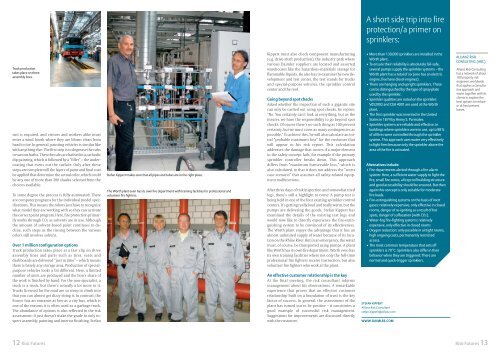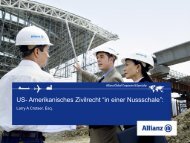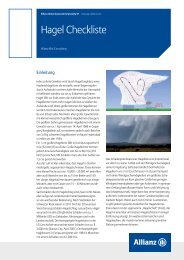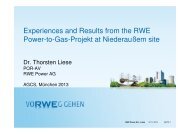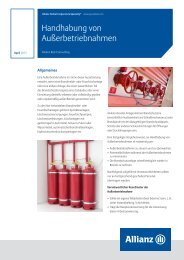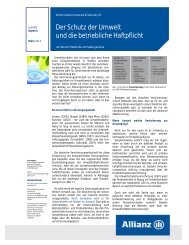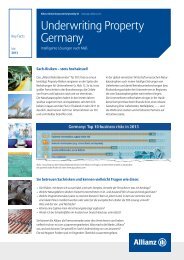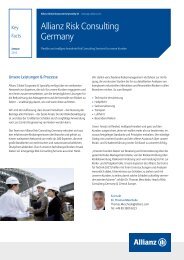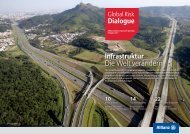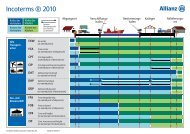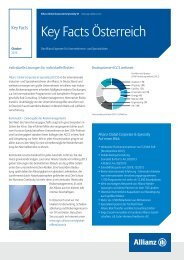Energy - Allianz Global Corporate & Specialty
Energy - Allianz Global Corporate & Specialty
Energy - Allianz Global Corporate & Specialty
Create successful ePaper yourself
Turn your PDF publications into a flip-book with our unique Google optimized e-Paper software.
Truck production<br />
takes place on three<br />
assembly lines.<br />
suit is required, and visitors and workers alike must<br />
enter a wind booth where they are blown clean from<br />
head to toe. In general, painting vehicles is similar like<br />
with anything else: The first step is to degrease the cabs<br />
in various baths. Then the cabs are bathed in a cathodic<br />
dip painting, which is followed by a “filler” – the undercoating<br />
that evens out the surface. Only after these<br />
steps are complete will the layers of paint and final coat<br />
be applied that determine the actual color, which could<br />
be any one of more than 200 shades selected from the<br />
choices available.<br />
To some degree the process is fully automated: There<br />
are computer programs for the individual model spec -<br />
ifications. This means the robots just have to recognize<br />
what model they are working with so they can activate<br />
the correct paint program. Here, fire protection primar -<br />
ily works through CO2 as solvents are in use. Although<br />
the amount of solvent-based paint continues to de -<br />
cline, such steps as the rinsing between the various<br />
colors still involves solvent.<br />
Over 1 million configuration options<br />
Truck production takes place at a fast clip on three<br />
assembly lines and parts such as tires, seats and<br />
dashboards are delivered “just in time” – which means<br />
there is barely any storage area. Production of specialpurpose<br />
vehicles looks a bit different. Here, a limited<br />
number of units are produced and the lion’s share of<br />
the work is finished by hand. For the non-specialist, a<br />
truck is a truck, but there’s actually a lot more to it.<br />
Trucks licensed for the road are so steep to climb into<br />
that you can almost get dizzy doing it. In contrast, the<br />
Econic has an entrance as low as a city bus, which is<br />
one of the reasons it is often used as a garbage truck.<br />
The abundance of options is also reflected in the risk<br />
assessment: It just doesn’t make the grade to only inspect<br />
assembly, painting and interior finishing. Stefan<br />
12 Risk Futures<br />
Stefan Kippert makes sure that all pipes and tubes are in the right place.<br />
The Wörth plant even has its own fire department with training facilities for professional and<br />
volunteer fire fighters.<br />
Kippert must also check component manufacturing<br />
(e.g. drive-shaft production), the industry park where<br />
various Daimler suppliers are located and assorted<br />
warehouses like the hazardous-materials storage for<br />
flammable liquids. He also has to examine the new development<br />
and test center, the test stands for trucks<br />
and special-purpose vehicles, the sprinkler control<br />
center and the roof.<br />
Going beyond spot checks<br />
Asked whether the inspection of such a gigantic site<br />
can only be carried out using spot checks, he replies:<br />
“No. You certainly can’t look at everything, but as the<br />
insurer, we have the responsibility to go beyond spot<br />
checks. Of course there’s no such thing as 100 percent<br />
certainty, but we must cover as many contingencies as<br />
possible.” To achieve this, he will also calculate an initial<br />
“probable maximum loss” for the customer that<br />
will appear in his risk report. This calculation<br />
addresses the damage that occurs if a major element<br />
in the safety concept fails, for example if the primary<br />
sprinkler controller breaks down. This approach<br />
differs from “maximum foreseeable loss,” which is<br />
also calculated, in that it does not address the “worst<br />
case scenario” that assumes all safety-related equipment<br />
malfunctions.<br />
After three days of risk inspection and somewhat tired<br />
legs, there’s still a highlight to come: A pump test is<br />
being held in one of the four existing sprinkler control<br />
centers. It’s getting really loud and really warm, but the<br />
pumps are delivering the goods. Stefan Kippert has<br />
examined the details of the existing test logs and<br />
would now like to directly experience the fire-extinguishing<br />
system to be convinced of its effectiveness.<br />
The Wörth plant enjoys the advantage that it has an<br />
almost unlimited supply of water because of its loca -<br />
tion on the Rhine River. But in an emergency, the water<br />
must, of course, be transported using pumps. A plant<br />
like Wörth has its own fire department. Wörth even has<br />
its own training facilities where not only the full-time<br />
professional fire fighters receive instruction, but also<br />
volunteer fire fighters who work at the plant.<br />
An effective customer relationship is the key<br />
At the final meeting, the risk consultant informs<br />
management about his observations. A remarkable<br />
experience that proves that an effective customer<br />
relationship built on a foundation of trust is the key<br />
factor of success. In general, the assessment of the<br />
plant has turned out to be positive – it constitutes a<br />
good example of successful risk management.<br />
Suggestions for improvements are discussed directly<br />
with the customer.<br />
A short side trip into fire<br />
protection/a primer on<br />
sprinklers:<br />
• More than 130,000 sprinklers are installed in the<br />
Wörth plant.<br />
• To ensure their reliability is absolutely fail-safe,<br />
several pumps supply the sprinkler systems – the<br />
Wörth plant has a total of six (one has an electric<br />
engine, five have diesel engines).<br />
• There are hanging and upright sprinklers. These<br />
can be distinguished by the type of spray plate<br />
used by the sprinkler.<br />
• Sprinkler qualities are noted on the sprinkler:<br />
VdS2092 and CEA 4001 are used at the Wörth<br />
plant.<br />
• The first sprinkler was invented in the United<br />
States in 1874 by Henry S. Parmalee.<br />
• Sprinkler systems are reliable and effective. In<br />
buildings where sprinklers were in use, up to 98 %<br />
of all fires were controlled through the sprinkler<br />
system. This approach uses water very effectively<br />
to fight fires because only the sprinkler above the<br />
area of the fire is activated.<br />
Alternatives include:<br />
• Fire departments alerted through a fire alarm<br />
system: Here, a sufficient water supply to fight the<br />
fire, small fire zones, a fireproof building structure<br />
and good accessibility should be ensured. But then<br />
again this concept is only suitable for moderate<br />
fire loads.<br />
• Fire-extinguishing systems on the basis of inert<br />
gases: relatively expensive, only effective in closed<br />
rooms, danger of re-igniting as a result of hot<br />
spots, danger of suffocation (with CO2).<br />
• Water-fog fire-fighting systems: relatively<br />
expensive, only effective in closed rooms<br />
• Oxygen reduction: only possible in airtight rooms,<br />
high ongoing costs, permanently restricted<br />
access.<br />
• The most common temperature that sets off<br />
sprinklers is 70°C. Sprinklers also differ in their<br />
behavior when they are triggered: There are<br />
normal and quick-trigger sprinklers.<br />
STEFAN KIPPERT<br />
<strong>Allianz</strong> Risk Consultant<br />
stefan.kippert@allianz.com<br />
WWW.DAIMLER.COM<br />
ALLIANZ RISK<br />
CONSULTING (ARC)<br />
<strong>Allianz</strong> Risk Consulting<br />
has a network of about<br />
100 property risk<br />
engineers worldwide<br />
that applies a consultative<br />
approach and<br />
works together with its<br />
clients to explore the<br />
best options to reduce<br />
or at best prevent<br />
losses.<br />
Risk Futures 13


